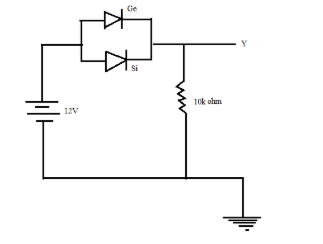
Two junction diodes one of germanium ( Ge ) and another of silicon (Si ) are connected as shown in the figure to a battery of emf


Answer
508.8k+ views
Hint: Students can apply the concept of Kirchoff’s voltage law to determine the potential at terminal
Complete step by step solution:
In the given circuit, both the germanium and silicon diodes are forward biased, that is they allow the flow of current through them. Now as the circuit is switched on, current will start flowing across the circuit, starting from the battery towards the diodes. As it has been already mentioned in the question that the Si diode conducts at
So, as current passes through the circuit and reaches the Ge diode, there will be a voltage drop across the diode and current will flow through it, but in the case of Si, as it conducts only at
Now, the voltage at terminal
By using Kirchhoff's Voltage law (KVL),
If the voltage at the terminal
Therefore the voltage at terminal
The answer is option
Note: In this particular circuit, students must not get confused as to which law to be used, KVL or KCL (Kirchoff’s Current Law). This question has provided us the information regarding the voltages across the different parts of the circuit, so it is always preferable to use the KVL rather than KCL. Students must also pay attention to the fact that current follows always the shortest possible path.
Complete step by step solution:
In the given circuit, both the germanium and silicon diodes are forward biased, that is they allow the flow of current through them. Now as the circuit is switched on, current will start flowing across the circuit, starting from the battery towards the diodes. As it has been already mentioned in the question that the Si diode conducts at
So, as current passes through the circuit and reaches the Ge diode, there will be a voltage drop across the diode and current will flow through it, but in the case of Si, as it conducts only at
Now, the voltage at terminal
By using Kirchhoff's Voltage law (KVL),
If the voltage at the terminal
Therefore the voltage at terminal
The answer is option
Note: In this particular circuit, students must not get confused as to which law to be used, KVL or KCL (Kirchoff’s Current Law). This question has provided us the information regarding the voltages across the different parts of the circuit, so it is always preferable to use the KVL rather than KCL. Students must also pay attention to the fact that current follows always the shortest possible path.
Recently Updated Pages
Master Class 9 General Knowledge: Engaging Questions & Answers for Success

Master Class 9 English: Engaging Questions & Answers for Success

Master Class 9 Science: Engaging Questions & Answers for Success

Master Class 9 Social Science: Engaging Questions & Answers for Success

Master Class 9 Maths: Engaging Questions & Answers for Success

Class 9 Question and Answer - Your Ultimate Solutions Guide

Trending doubts
Give 10 examples of unisexual and bisexual flowers

Draw a labelled sketch of the human eye class 12 physics CBSE

Differentiate between homogeneous and heterogeneous class 12 chemistry CBSE

Differentiate between insitu conservation and exsitu class 12 biology CBSE

What are the major means of transport Explain each class 12 social science CBSE

Draw a diagram of a flower and name the parts class 12 biology ICSE




